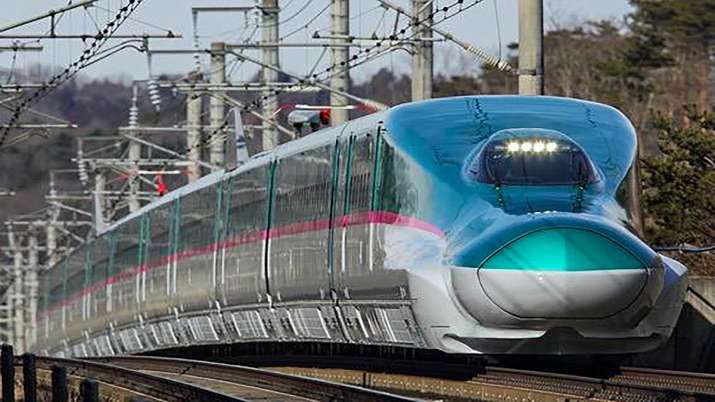
E5 series Shinkansen (Japan’s bullet train), which will be modified for use as rolling stock for the Mumbai-Ahmedabad High Speed Rail Corridor project.
Highlight
- Bullet train to be tested in India at a speed of 350 kmph, officials said
- The test speed of the train is equal to the take-off speed of the airplane
- An official said, we will test at a speed of 350 kmph, but the operating speed will be 320 kmph.
Bullet train trials in India will be conducted at a speed of 350 kmph, which is equivalent to the take-off speed of an airplane, officials said on Wednesday.
The first bullet train project in India is being constructed between Mumbai and Ahmedabad, a flagship project of the Modi government.
He said the first such test would be between Bilimora and Surat in Gujarat in 2026, followed by other sections. The operating speed of the trains will be 320 kmph.
Bullet train will prove to be a game changer in India
“This will be a gamechanger for passengers and competition for air travel. Bullet trains will have shorter check-in times, more leg space and, above all, connectivity, which on-board airplanes are denied.
“We will test at a speed of 350 kmph, but the operating speed will be 320 kmph,” an official said.
Trains will run on special tracks called “Slab Track Systems” known as HSR technology for track construction patented by the Japanese.
Officials said that trains running at a speed of 350 kmph would be capable of plying on these tracks.
Sources said the services will come with fares on par with economy-class flights and the free-luggage limit is likely to be higher.
With the assembly elections in Gujarat, the emphasis is on expediting the project and taking a section for testing, especially in Gujarat where the National High Speed Rail Corporation Limited (NHSRCL) has already acquired 99 per cent of the required land. Is. ,
Construction being done with full span launching method
Using designs procured from Japan, the construction is being done through Full Span Launching Method (FLSM), one of the most sophisticated bridge construction techniques in the world. NHSRCL has constructed 200-250 pillars per month between Bilimora and Surat.
The longest (1.26 km) bridge under the project to withstand turbulent winds and tidal waves on river Narmada will be completed by July 2024.
100 per cent civil contracts have been awarded to Indian contractors for the construction of the entire route of 352 km in Gujarat and Dadra and Nagar Haveli.
In Gujarat, contracts for 237 km of track work have already been awarded and the remaining 115 km will be awarded soon.
Out of 352 km, Detailed Geotechnical Investigation (GTI) work (100-metre interval) has been completed over 330 km. Good drawings have been developed for construction for 165 km on the basis of GTI.
Officials said that construction work is in various stages at all the eight high speed railway stations from Vapi to Sabarmati.
The passenger terminal hub integrating HSR, Metro, BRT and two Indian railway stations at Sabarmati is expected to be completed by August this year.
The total length of the bullet train corridor is 508.17 km and the train is expected to take approximately 2 hours 58 minutes to travel between Ahmedabad and Mumbai, which includes eight stations in Gujarat and four in Maharashtra.
,With inputs from PTI,
read also , Bullet train will strengthen the identity of India and Mumbai: PM Modi
read also , A Glimpse of New Construction Techniques in Railways for India’s First Bullet Train Project